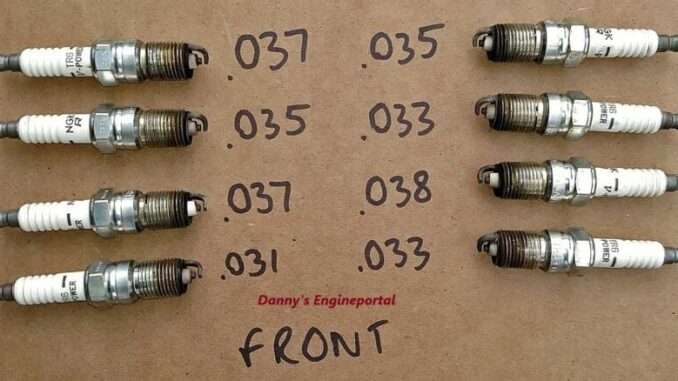
Learning how to read the condition of a spark plug, can be a valuable tuning aid.
You can determine a great deal about, your engine’s, overall operating condition. Usually, just by examining, the spark plugs insulator color.
So, a quick inspection can not only tell you, if it’s time for spark plug replacement. But, can also speak volumes, about your engines condition as well.
Consequently, if your vehicle has a little less spunk lately, it might be time for a Spark Plug change.

Is your engine running too lean? Too rich? Is there an issue with, oil control or ignition timing? Or is everything, just fine with your engine? Spark plug problems are common.
In general, a light tan/gray color tells you that, the spark plug is operating, at optimum temperature. And, that the engine, is in good condition.
Dark coloring, such as heavy black, wet or dry deposits, can indicate:
- A rich fuel condition.
- Too cold a heat range spark plug.
- A possible vacuum leak.
- Low compression.
- Overly late timing.
- Too large a plug gap.
Wet deposits, may be an indication of:
- A blown head gasket.
- Poor oil control from rings.
- Valve train problems.
- An extremely rich condition.
Depending on the type of the liquid, present at the firing tip.
Also, look for any signs of fouling or excessive heat. Because, this will help prevent, further deterioration of performance and possible engine damage.

#1 Normal Condition
- So, if the firing end of the spark plug is brown or light gray, the condition is judged as good. As a result, the spark plug, is functioning optimally.
#2 Dry and Wet Fouling
- Consequently, there are many different cases. If the insulation resistance, between the center electrode and the shell, is over 10 ohms, the engine will started normally. But, if the insulation resistance, drops to 0 ohms, the firing end is fouled, by either wet or dry carbon.
#3 Overheating
- When a spark plug overheats, deposits that have built up on the insulator tip, begin to melt. As a result, giving the insulator tip, a glazed or glossy appearance.
#4 Deposits
- So, oil leakage, fuel quality and the engine’s operating duration, will influence the accumulation of deposits.
#5 Lead Fouling
- Consequently, lead fouling usually appears, as yellow brown deposits, on the insulator nose. So, a resistance tester at room temperature, will not detect this. Because, lead compounds, combine at different temperatures. Finally, those formed at 370-470°C (700-790°F) having the greatest influence on lead resistance.
#6 Breakage
- As a result of thermal expansion and thermal shock, due to sudden heating or cooling, spark plugs can break.
#7 Normal Life
- A worn spark plug not only wastes fuel, but also strains the whole ignition system. This is because the larger gap (due to erosion), requires higher voltages.
#8 Abnormal Erosion
- So, abnormal electrode erosion, is caused by the effects of corrosion, oxidation and reaction with lead. Finally, resulting in, abnormal gap growth.
#9 Melting
- Above all, overheating, will cause spark plug melting. As a result, the electrode surface, is rather lustrous and uneven.
#10 Erosion, Corrosion and Oxidation
- So, the material of the electrode has oxidized. And, when the oxidation is heavy, it will be green on the surface. As a result, the surface of the electrodes, are also fretted and rough.
#11 Lead Erosion
- So, the tip of the ground electrode, looks chipped and its surface may be thinned. Another condition unique to leaded gasoline. Consequently, this condition is caused by, lead compounds, that react chemically with the electrodes at high temperatures. Furthermore, this makes the electrode material (nickel alloy) weak and brittle. Finally, this is caused by, too much lead in the fuel.

Conclusion
So, to keep your engine operating efficiently, don’t mix plugs, in varying states of wear. Either replace all the plugs, with new ones or clean, gap and reinstall, all the old ones.
BY DANNY BENDER




